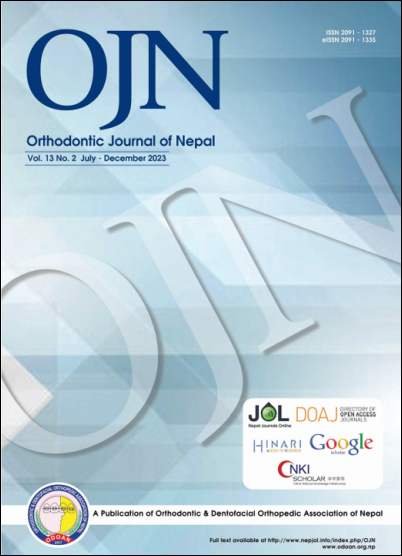Comparison of various nasal parameters in different anteroposterior jaw relationships and growth patterns
DOI:
https://doi.org/10.3126/ojn.v13i2.57790Keywords:
Cephalometric, Growth pattern, Nasal, Soft tissueAbstract
Introduction: Evaluation of the patient soft tissue is one of the most important considerations in the diagnosis and customized treatment plan to enhance the facial esthetics of the patient. Hence, the present study was conducted to evaluate the nasal parameters in different anteroposterior jaw dysplasia and its association with different growth patterns and any gender dimorphism.
Materials and Method: This study was conducted at the Chitwan Medical College in the Department of Orthodontics. Lateral Cephalogram of 100 patients with age ranging from 18-27 years were collected and traced manually. Various nasal parameters were then measured and descriptive statistics were performed followed by ANOVA tests to find out any statistical differences.
Result: Among 100 subjects, 48 had average growth pattern, 26 had horizontal pattern, and 26 had vertical pattern. Likewise, 41 samples had skeletal class I, 39 had skeletal class II, and 20 had skeletal class III relationship. Nose length was greater in vertical growth pattern and skeletal class I. Nasolabial angle was greater in vertical growth pattern and skeletal class II. Nasal depth was greater in horizontal growth pattern and skeletal class II. Lower nose to Frankfurt horizontal angle was greater in average growth pattern and skeletal class III. All the parameters showed greater value in males with no statistically significant difference between gender.
Conclusion: The present study showed that although different parameters showed variation among different malocclusions and growth pattern but it was not statistically significant.
Downloads
Downloads
Published
How to Cite
Issue
Section
License
Copyright (c) 2024 Orthodontic & Dentofacial Orthopedic Association of Nepal

This work is licensed under a Creative Commons Attribution 4.0 International License.
Copyright © held by Orthodontic & Dentofacial Orthopedic Association of Nepal
- Copyright on any research article is transferred in full to the Orthodontic & Dentofacial Orthopedic Association of Nepal upon publication in the journal. The copyright transfer includes the right to reproduce and distribute the article in any form of reproduction (printing, electronic media or any other form).
- Articles in the Orthodontic Journal of Nepal are Open Access articles published under the Creative Commons CC BY License (https://creativecommons.org/licenses/by/4.0/)
- This license permits use, distribution and reproduction in any medium, provided the original work is properly cited.




